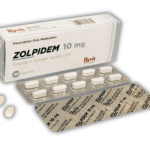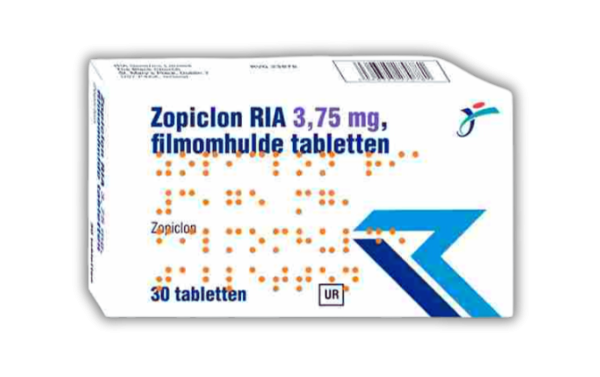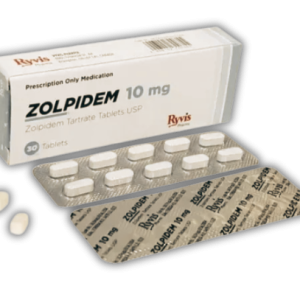Description
Zopiclone stands as one of the most widely prescribed medications for insomnia. Its complex pharmacological profile and potential for misuse continue to attract scientific attention. This cyclopyrrolone compound, while chemically distinct from benzodiazepines, works through similar mechanisms to provide short-term relief for sleep disorders.
Research shows that zopiclone reduces sleep latency, increases total sleep time, and improves sleep quality in adults. Still, its benefits come with risks that can’t be ignored.
The medication serves as both a therapeutic solution and a potential public health concern. Researchers have looked closely at its clinical applications and safety profile.
While zopiclone effectively treats various forms of insomnia, using it for more than four weeks raises red flags about tolerance, dependence, and withdrawal. Recent studies point to growing nonmedical usage, especially in the UK, where easy access and a reputation for safety have led to recreational use.
Understanding zopiclone’s full scientific profile means looking at its molecular mechanisms, clinical efficacy, adverse effects, and broader societal impact. Ongoing research keeps refining guidelines for safe use, while grappling with challenges around long-term dependence and misuse that shape both clinical practice and public health policy.
Pharmacological Profile of Zopiclone
Zopiclone was the first cyclopyrrolone compound to hit the market, with a mechanism that’s different from benzodiazepines but offers similar therapeutic benefits. The liver metabolizes about 95% of the drug before the body eliminates it.
Mechanism of Action
Zopiclone works as a non-benzodiazepine hypnotic by modulating the GABA_A receptor complex. It binds to a spot near—but not identical to—the benzodiazepine binding site.
This unique binding boosts GABAergic neurotransmission. Zopiclone increases how often chloride channels open, which leads to neuronal hyperpolarization and sedative effects.
The cyclopyrrolone structure sets zopiclone apart from benzodiazepines and barbiturates. Still, zopiclone manages to pull off the five main pharmacological activities seen in benzodiazepines.
These include hypnotic, anxiolytic, muscle relaxant, anticonvulsant, and amnestic properties. Its selectivity for sleep-related effects makes it a go-to for insomnia.
Pharmacokinetics and Metabolism
The liver does most of the heavy lifting when it comes to metabolizing zopiclone. Only about 5% leaves the body unchanged in urine.
The drug’s half-life and how the liver clears it play a big role in its duration and side effects. Hepatic enzymes break it down through oxidation, and the kidneys flush out the metabolites.
So, kidney function matters for getting rid of the drug completely. Bioavailability and distribution affect the therapeutic window, with peak plasma concentrations showing up within 1-2 hours after taking it orally.
People process zopiclone differently, depending on their liver enzymes. Older adults might need dose adjustments because aging can slow liver function.
Comparison with Other Hypnotic Agents
Zopiclone works about as well as classic benzodiazepines for insomnia. For example, 5mg zopiclone stacks up closely against 15mg flurazepam and 1mg flunitrazepam when it comes to reducing sleep latency.
But zopiclone often comes out ahead on toxicity profile and dependence potential. It keeps its effectiveness high but usually has lower toxicity than old-school benzodiazepines.
Clinical trials show that 7.5mg zopiclone matches the hypnotic punch of 5mg nitrazepam. Its non-benzodiazepine structure might mean less rebound insomnia and fewer withdrawal issues.
Zopiclone’s unique receptor binding could explain its better safety margin. It offers solid short-term insomnia relief, with a reduced risk of building up tolerance compared to benzodiazepines.
Clinical Application in Insomnia
Zopiclone proves clinically effective for insomnia, cutting down sleep latency and boosting total sleep time. It seems especially promising for older adults when doctors choose doses carefully.
Efficacy in Short-Term Treatment
Trials show that zopiclone improves several sleep parameters over short periods. People fall asleep faster, wake up less during the night, and spend less time awake after initially falling asleep, compared to placebo.
Patients report longer total sleep and better sleep quality. Zopiclone works about as well as benzodiazepines but tends to cause fewer side effects.
Key Sleep Improvements:
- Reduced time to fall asleep
- Fewer night-time awakenings
- Increased sleep duration
- Enhanced sleep architecture
Most studies run for 2-7 weeks. Evidence so far suggests zopiclone keeps working during that time without much tolerance developing.
Its short elimination half-life means fewer groggy mornings. That makes it a decent choice for people who need to stay alert and sharp the next day.
Effectiveness in Older Adults
Studies focusing on older adults show zopiclone can work well for this group. Patients aged 65 and up see improved sleep with manageable side effects.
Older adults fall asleep quicker and sleep longer. Zopiclone helps both those living at home and those in care facilities.
Population-Specific Benefits:
- Lower risk of falls than traditional benzodiazepines
- Minimal cognitive impact
- Fewer anticholinergic effects
- Generally better tolerated
Insomnia affects up to half of older adults. Zopiclone tackles this widespread problem while keeping safety in mind for the elderly.
It even works for older people with multiple health conditions affecting sleep. Studies show benefits for these complex cases, too.
Dosage and Administration Guidelines
For most adults, the standard starting dose is 7.5mg taken orally before bed. Older adults usually start at 3.75mg to limit side effects but still get results.
Recommended Dosing:
- Adults (18-64 years): 7.5mg before bed
- Older adults (≥65 years): 3.75mg before bed
- Hepatic impairment: 3.75mg before bed
- Renal impairment: No dose adjustment needed
Keep treatment as short as possible. Most guidelines suggest using zopiclone for no more than 2-4 weeks to avoid dependence and tolerance.
Take zopiclone right before bedtime, and only if you can get 7-8 hours of uninterrupted sleep. Eating beforehand can slow absorption and make it less effective.
If 3.75mg doesn’t cut it for older adults, doctors might increase to 7.5mg, but they should do so slowly and keep a close eye on things.
Patient Selection Criteria
Doctors usually prescribe zopiclone to adults with proven insomnia who struggle to fall or stay asleep. People should have tried non-drug approaches before starting zopiclone.
Ideal Candidates:
- Diagnosed with primary insomnia
- Sleep efficiency under 75%
- Non-responsive to sleep hygiene steps
- No current substance abuse
- Stable mental health
Doctors should avoid zopiclone in people with severe respiratory problems, sleep apnea, or myasthenia gravis. Those with liver issues need adjusted doses and careful monitoring.
Extra caution is necessary for people with depression, anxiety, or any history of substance abuse. These groups need more oversight and might be better off with other treatments.
Pregnant and breastfeeding women should steer clear of zopiclone because of possible risks to the baby. Other sleep strategies are safer for them.
Risks, Adverse Effects, and Dependence
Zopiclone comes with several important safety considerations. Common side effects and some serious reactions can occur, and there’s a real risk of dependence, especially if used longer than recommended.
Common and Severe Adverse Effects
Many people notice a metallic or bitter taste in the mouth after taking zopiclone—up to 40% experience this. The taste can linger for hours. Drowsiness and dizziness are also frequent, especially in the morning after a nighttime dose.
Other common side effects include:
- Cognitive impairment and memory issues
- Dry mouth and stomach problems
- Headache and tiredness
- Coordination trouble
Serious side effects can be more troubling. Older adults face higher risks of falls and fractures due to balance problems. Respiratory depression might happen, particularly if zopiclone mixes with alcohol or other depressants.
Some people experience complex sleep behaviors—like sleepwalking, sleep-driving, or even cooking while asleep and remembering nothing afterward. Rare but severe allergic reactions can also occur, with symptoms like rashes, swelling, or trouble breathing.
Potential for Dependence and Misuse
Despite early claims, zopiclone can be habit-forming. Physical dependence can show up within weeks of regular use. Even animal studies have shown that monkeys will self-administer zopiclone, suggesting it has reinforcing effects.
Risk factors for dependence include:
- Past substance abuse
- Dependent personality traits
- Using zopiclone longer than 2-4 weeks
- Taking higher doses than prescribed
Psychological dependence often appears as anxiety about sleeping without the drug. Some people increase their dose without a doctor’s input when tolerance sets in, which only ups the risk of side effects and dependence.
Zopiclone’s benzodiazepine-like action at GABA receptors helps explain its dependence potential. There’s also cross-tolerance with benzodiazepines, so switching between them needs medical supervision.
Doctors should watch patients closely for any signs of misuse or dependence while they’re on zopiclone.
Withdrawal Symptoms and Management
Stopping zopiclone suddenly after regular use can trigger withdrawal. Symptoms usually start within 24-48 hours and may last for weeks, depending on how long and how much someone has taken.
Common withdrawal symptoms include:
- Rebound insomnia
- Anxiety and panic
- Tremors and sweating
- Nausea and vomiting
- Strange perceptions
In severe cases, withdrawal may bring on seizures, especially in those who’ve used high doses for a long time. Rebound insomnia can actually be worse than the original sleep problems.
Gradually tapering the dose over several weeks is the safest way to quit. A typical plan involves cutting the dose by about 25% each week, but some people need to go even slower.
Support includes sleep hygiene advice and non-drug interventions. Sometimes, a doctor may use longer-acting benzodiazepines temporarily to help manage tough withdrawal symptoms.
Patients need close monitoring during withdrawal because complications can pop up.
Nonmedical Usage and Public Health Concerns
Zopiclone misuse has become a serious public health issue in the UK. Around 635,000 adults use it nonmedically each year, often without a prescription and sometimes mixed with other substances.
This creates complicated patterns of harm that call for targeted interventions and better awareness.
Patterns of Nonmedical Use
Recent UK studies show that 1.2% of adults have used zopiclone nonmedically in the past year. That’s roughly 635,000 people taking it outside the prescribed guidelines—a surprising number, honestly.
The highest rates of misuse pop up among people who also use heroin. Prevalence in this group hits 5.4%.
This pattern points to polydrug use in some of the most vulnerable populations. It’s a tough problem to untangle.
Acquisition Methods:
- Without prescription: 75.6% of nonmedical users
- With prescription: 33.9% of nonmedical users
- Online purchase: Available through various internet sources
- Friends/family: Common informal distribution network
Emergency departments have seen a big jump in cases linked to recreational zopiclone use. Most of these cases involve more than one substance, which makes treatment messy and unpredictable.
Large studies confirm that people can get zopiclone from both legal and illegal sources. Its easy access has made it part of the routine in established drug-using circles.
Associated Harms and Social Impact
Zopiclone can cause dependence more quickly than other Z-drugs like zaleplon. Users often find themselves needing higher doses to get the same effects.
Primary Health Risks:
- Physical dependence: Can set in fast when used regularly
- Withdrawal symptoms: Sometimes severe, often lingering
- Overdose potential: Especially risky with alcohol or opioids
- Cognitive impairment: Memory issues and trouble focusing
The mix of zopiclone with stimulants is raising new concerns. People using cocaine, amphetamines, or MDMA seem more likely to misuse Z-drugs or benzos, though research here is pretty thin so far.
Falls and fractures are a big risk, especially for older adults. Sedation from zopiclone slows reaction times and ups the chance of accidents.
Social fallout includes job problems, strained relationships, and more trips to the doctor. Many users get the drug without any medical oversight, so they miss out on chances for intervention.
Preventative Strategies and Recommendations
Public health policymakers need to take a broad approach to all Z-drugs, not just zopiclone. The British National Formulary says not to prescribe for more than four weeks, but adherence is all over the map.
Key Interventions:
- Stringent prescription management systems
- Limited duration and dosage protocols
- Enhanced monitoring of long-term prescriptions
- Improved prescriber education programmes
Healthcare providers could use better training to spot nonmedical use. Early intervention should focus on people at high risk, especially those mixing with heroin or stimulants.
Online sales need tighter regulation, maybe even international cooperation, since supply chains cross borders. Monitoring internet pharmacies is a headache but probably necessary.
Treatment services should work on protocols tailored to zopiclone dependence. Surveillance systems need to catch up, since current data probably miss a lot of cases.
Research should look into how zopiclone interacts with stimulants and how to build better withdrawal protocols. Knowing more about how people get the drug could help target prevention.
Frequently Asked Questions
Zopiclone brings up plenty of clinical questions—therapeutic use, safety, and its potential for dependence. Healthcare providers often ask about dosing, how it stacks up against other hypnotics, and the risks of long-term use.
What are the current recommendations for the use of Zopiclone in the treatment of insomnia?
Guidelines say to use zopiclone for short-term insomnia, usually 2-4 weeks max. The standard adult dose is 7.5 mg right before bed.
For older adults or those with liver problems, start at 3.75 mg nightly. That lower dose helps reduce the risk of heavy sedation and memory issues.
Start with the lowest effective dose and keep treatment as brief as possible. Doctors should check in regularly to see if continued treatment is still needed.
Long-term prescribing past four weeks needs a solid reason and close monitoring. Sometimes intermittent dosing can help avoid tolerance.
How does Zopiclone compare to other hypnotics in terms of efficacy and safety?
Zopiclone works about as well as benzodiazepine hypnotics for falling asleep faster and improving sleep quality. Clinical trials back up its effectiveness for primary insomnia.
It seems to cause less next-day grogginess than benzos, likely due to its shorter half-life. Short-term, it also appears less likely to cause tolerance.
At first, many thought Z-drugs like zopiclone were less addictive than benzos. But newer evidence suggests the risks of dependence and withdrawal are pretty similar.
Studies show zopiclone causes fewer muscle relaxant and anticonvulsant effects compared to benzodiazepines. Researchers chalk this up to its preference for certain GABAA receptor subtypes.
What are the known side effects and risks associated with long-term Zopiclone administration?
Common side effects: metallic taste, drowsiness, dizziness, and dry mouth. These crop up in 10-40% of people on standard doses.
Memory and cognitive problems can happen, especially at higher doses or with longer use. Some folks experience anterograde amnesia that messes with short-term memory.
With long-term use, people often need higher doses to get the same sleep benefits. This can spiral into daily use way above the recommended amount.
Withdrawal can bring anxiety, tremors, sweating, palpitations, and rebound insomnia. In bad cases, people might have hallucinations or impulsive behavior, which really needs medical attention.
What mechanisms of action underpin the sedative properties of Zopiclone?
Zopiclone acts as a positive allosteric modulator at GABAA receptors, boosting GABA’s natural calming effect in the brain. That’s what gives it its sedative and hypnotic punch.
The drug tends to bind to GABAA receptors with the α1 subunit. These are found all over the cerebral cortex and link to sedation.
At normal doses, zopiclone’s preference for α1 subunits means fewer anti-anxiety and muscle relaxant effects. At higher doses, though, this selectivity fades.
Some new research hints that big doses let it interact with α2 and α3 subtypes, too. Maybe that’s why some users report euphoria or extra calming effects.
How is Zopiclone metabolised and eliminated from the body, and what are the implications for different patient populations?
The liver metabolizes zopiclone mainly through the cytochrome P450 system. It creates two main metabolites: zopiclone-N-oxide and N-desmethylzopiclone.
In healthy adults, the elimination half-life ranges from about 3.5 to 6.5 hours. Older adults process the drug more slowly, so they need lower doses to avoid too much sedation.
People with liver problems clear zopiclone much less efficiently. Dose adjustments are crucial here to prevent toxicity.
Renal impairment doesn’t change elimination much, since the liver does most of the work. Still, severe kidney issues call for caution.
What are the latest findings on Zopiclone’s potential for dependency and withdrawal symptoms?
Recent studies are starting to challenge the old idea that zopiclone has a low risk of abuse compared to benzodiazepines. Some case reports even describe people developing severe dependence, especially at daily doses over 100 mg.
Dependency can show up within just a few weeks of regular use. Folks with pre-existing sleep problems or psychiatric conditions seem especially at risk.
Chronic insomnia might make someone more vulnerable to abusing zopiclone. It’s a detail that’s easy to overlook but probably matters a lot.
Withdrawal symptoms run the gamut—autonomic instability, psychiatric issues, and really rough rebound insomnia. These symptoms can hang around for weeks after stopping the drug.
Global data points to rising zopiclone use, even as benzodiazepine prescriptions drop. That shift makes me wonder if we’re facing a new wave of long-term prescribing problems and a broader risk of dependence out there.



Reviews
There are no reviews yet.